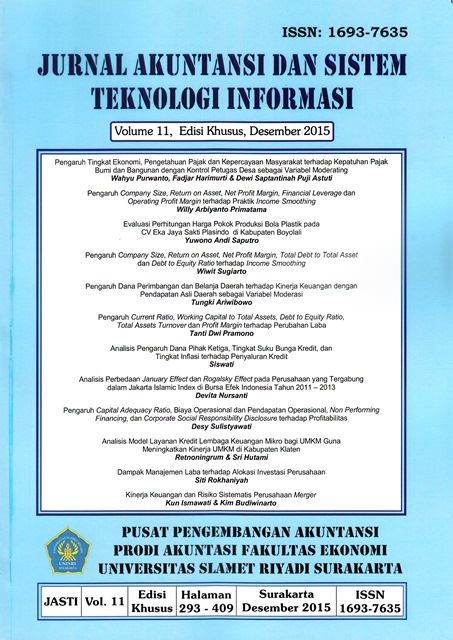PENGARUH CURRENT RATIO, WORKING CAPITAL TO TOTAL ASSETS, DEBT TO EQUITY RATIO, TOTAL ASSETS TURNOVER DAN PROFIT MARGIN TERHADAP PERUBAHAN LABA
Abstract
Purpose of this research to knows the effect of the current ratio, working capital to total assets, debt to equity ratio, total asset turnover, and net profit margin to earnings changes. The population are trading company at sub-sector trading of the goods production period of 2011 – 2013 with a sample of 16 companies. Data collection techniques used documentation. Data were analyzed used multiple linear regression analysis and, coefficient determination test, test and test T F. The results showed that current ratio has significant negative effect on earnings changes. Working Capital to Total Assets has negative effect but not significant to earnings changes. Debt to Equity Ratio has significant negative effect on earnings changes. Total Assets Turnover has positive and significant effect on earnings changes. Net Profit Margin has positive and significant effect on earnings changes. The coefficient of determination are 0.384 means that influence of variable CR, WCTA, DER, TATO and NPM earnings change amounted to 38.4 percent, while the remaining 61.6 percent is influenced by other variables not studied, for example, is the gross profit margin or return on assets. Keywords: current ratio, working capital to total asset, debt to equity ratio, total asset turnover, net profit marginDownloads
Published
2016-01-13
Issue
Section
Artikel
License
Authors who publish this journal agree to the following terms:
- Authors retain copyright and grant the journal right of first publication with the work simultaneously licensed under a Creative Commons Attribution License that allows others to share the work with an acknowledgement of the work's authorship and initial publication in this journal.
- Authors can separately make additional contractual arrangements for non-exclusive distribution published by the journal (e.g., publish it in a book), with an acknowledgement of its initial publication in this journal.
- Authors are allowed and encouraged to send their work via online (e.g., in the institutional repositories or their website) after published by the journal.










